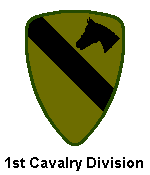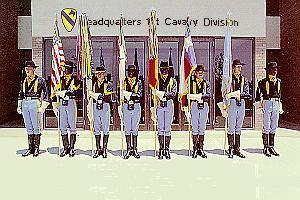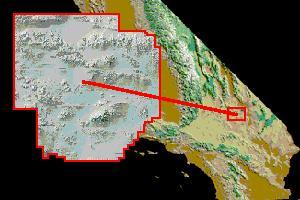




 |
|---|
| 1st Cavalry Division Headquarters |
|---|
| |
|---|

 Knowing that the future is always unpredictable and that the basic ingredient
of success of a military organization is a structure that allows the greatest
speed and flexibility in adapting technologies in the ever changing combat
organizations. Upon return to the United States, The 1st Cavalry Division
initiated the first of a series of reorganizations in the period May 1991 to
August 1993. The Division rebuilt, as a new contingency force, was ready to
deploy anywhere in the world on a moments notice.
Knowing that the future is always unpredictable and that the basic ingredient
of success of a military organization is a structure that allows the greatest
speed and flexibility in adapting technologies in the ever changing combat
organizations. Upon return to the United States, The 1st Cavalry Division
initiated the first of a series of reorganizations in the period May 1991 to
August 1993. The Division rebuilt, as a new contingency force, was ready to
deploy anywhere in the world on a moments notice.
 On 21 May 1991, the 1st Cavalry Division became the largest division in the
Army, with the reactivation of its 3rd (Greywolf) Brigade. Organic units
included in this reactivation were formally assigned to the 1st (Tiger)
Brigade, 2nd Armored Division that, at times, had been attached to the 1st
Cavalry Division during the Gulf War. Units filling out the 3rd Brigade were
3rd Battalion, 41st Infantry Regiment, 1st and 3rd Battalions, 67th Armor
Regiment, 1st Battalion, 3rd Field Artillery Regiment and the 502nd
(later redesignated as the 215th) Forward Support Battalion.
On 21 May 1991, the 1st Cavalry Division became the largest division in the
Army, with the reactivation of its 3rd (Greywolf) Brigade. Organic units
included in this reactivation were formally assigned to the 1st (Tiger)
Brigade, 2nd Armored Division that, at times, had been attached to the 1st
Cavalry Division during the Gulf War. Units filling out the 3rd Brigade were
3rd Battalion, 41st Infantry Regiment, 1st and 3rd Battalions, 67th Armor
Regiment, 1st Battalion, 3rd Field Artillery Regiment and the 502nd
(later redesignated as the 215th) Forward Support Battalion.
 In October of 1992 the new Engineer Brigade, 1st Cavalry Division was
activated and organized. Though the "Engineering Restructuring Initiative" of
the Army, the nucleus of the Brigade was formed around the division's historic
8th Engineer (Combat) Battalion. Additional organic units were assigned to the
Brigade. The 20th Engineer Battalion was transferred from Ft. Campbell,
Kentucky and the 91st Engineer Battalion was activated to complete the
alignment of the Brigade.
In October of 1992 the new Engineer Brigade, 1st Cavalry Division was
activated and organized. Though the "Engineering Restructuring Initiative" of
the Army, the nucleus of the Brigade was formed around the division's historic
8th Engineer (Combat) Battalion. Additional organic units were assigned to the
Brigade. The 20th Engineer Battalion was transferred from Ft. Campbell,
Kentucky and the 91st Engineer Battalion was activated to complete the
alignment of the Brigade.
 In November 1992, the unit designations and colors for the battalions from the
former (Tiger) Brigade were returned to 2nd Armored Division in preparation
for their redesignations at Ft. Hood on 02 December 1992. This action was done
to realign the historical designations with their parent divisions.
In November 1992, the unit designations and colors for the battalions from the
former (Tiger) Brigade were returned to 2nd Armored Division in preparation
for their redesignations at Ft. Hood on 02 December 1992. This action was done
to realign the historical designations with their parent divisions.
 Subsequently, on 29 November, the 1st Cavalry Division redesignated, realigned
and restored the former (Tiger) Brigade, giving its members the titles of its
historical units. These changes included:
Subsequently, on 29 November, the 1st Cavalry Division redesignated, realigned
and restored the former (Tiger) Brigade, giving its members the titles of its
historical units. These changes included:
- 3rd Battalion, 41st Infantry Regiment redesignated as 1st Battalion, 9th
Cavalry Regiment,
- 1st Battalion, 67th Armor Regiment redesignated as 3rd Battalion, 8th
Cavalry Regiment and
- 1st Battalion, 3rd Field Artillery redesignated as 2nd Battalion, 82nd
Field Artillery.
 On 16 December 1992, other 1st Cavalry Division units were redesignated and
restored, giving them the titles of their historical units. These changes
included:
On 16 December 1992, other 1st Cavalry Division units were redesignated and
restored, giving them the titles of their historical units. These changes
included:
- 1st Battalion, 32nd Armor Regiment redesignated as 2nd Battalion, 12th
Cavalry Regiment,
- 3rd Battalion, 32nd Armor Regiment redesignated as 1st Battalion, 12th
Cavalry Regiment and
- "A" Battery, 333rd Field Artillery redesignated as "B" Battery, 26th Field
Artillery.
 By 11 August 1993, the reflagging actions were completed when the 4th
Battalion, 6th Infantry, 2nd Armored Division was reflagged the 2nd Battalion,
7th Cavalry Regiment which was assigned to the First Team's 3rd (Greywolf)
Brigade. Following this last reorganization, the 1st Cavalry Division remained
the largest division of the Army and the only armored contingency force, ready
to deploy anywhere in the world at a moments notice.
By 11 August 1993, the reflagging actions were completed when the 4th
Battalion, 6th Infantry, 2nd Armored Division was reflagged the 2nd Battalion,
7th Cavalry Regiment which was assigned to the First Team's 3rd (Greywolf)
Brigade. Following this last reorganization, the 1st Cavalry Division remained
the largest division of the Army and the only armored contingency force, ready
to deploy anywhere in the world at a moments notice.
 |
|---|
| National Training Center, Ft. Irwin |
|---|
| |
|---|
Since the reorganization, the First Team has taken great strides to preserve
its heritage and live up to the legends created by its forefathers.It has
placed training, maintaining readiness and staying on the leading edge of the
warfare technology of today are top priorities. To support this initiative on
a continuing basis, the 1st Cavalry Division has deployed brigades to two
offsite training centers.
 The first is the National Training Center at Ft. Irwin located in the High
Mojave Desert of California. This facility encompasses one thousand square
miles for maneuver training against the best trained opposing force in the
world. Its mission is to provide tough, realistic combined arms training at
battalion task force level using both live fire and opposing forces. The
National Training Center has a computerized, live-fire complex with
sophisticated targetry, a full-time opposing force, a state-of-the-art range
instrumentation system that monitors training battles, and full-time combat
trainers who observe and control units during exercises.
The first is the National Training Center at Ft. Irwin located in the High
Mojave Desert of California. This facility encompasses one thousand square
miles for maneuver training against the best trained opposing force in the
world. Its mission is to provide tough, realistic combined arms training at
battalion task force level using both live fire and opposing forces. The
National Training Center has a computerized, live-fire complex with
sophisticated targetry, a full-time opposing force, a state-of-the-art range
instrumentation system that monitors training battles, and full-time combat
trainers who observe and control units during exercises.
 The second training actions are based upon a training agreement between the
US and Kuwait. Following the Gulf War, members of US Central Command's Army
component and the armed forces of Kuwait agreed to participate in a series of
Combined Exercises held within the framework of the Mutual Defense Cooperation
Agreement between Kuwait and the United States. In these exercises, Army
battalions rotate into Camp Doha for training with the Kuwaiti while brigade
command elements rotate into various locations in the country to gain
familiarity with the terrain to develop and practice a mutual set of defensive
postures. These exercises represented an opportunity for US Army forces to
work with Kuwaiti armed forces in country while at the same time demonstrating
US capability and commitment to the region.
The second training actions are based upon a training agreement between the
US and Kuwait. Following the Gulf War, members of US Central Command's Army
component and the armed forces of Kuwait agreed to participate in a series of
Combined Exercises held within the framework of the Mutual Defense Cooperation
Agreement between Kuwait and the United States. In these exercises, Army
battalions rotate into Camp Doha for training with the Kuwaiti while brigade
command elements rotate into various locations in the country to gain
familiarity with the terrain to develop and practice a mutual set of defensive
postures. These exercises represented an opportunity for US Army forces to
work with Kuwaiti armed forces in country while at the same time demonstrating
US capability and commitment to the region.
 Since the 1992 reorganization, elements of the First Team have returned to
Kuwait no less than a dozen times in addition to a crisis situation when Iraq
again threatened the borders of Kuwait. These actions and timing are detailed
in the chapter that follows.
Since the 1992 reorganization, elements of the First Team have returned to
Kuwait no less than a dozen times in addition to a crisis situation when Iraq
again threatened the borders of Kuwait. These actions and timing are detailed
in the chapter that follows.

 As you journey through the history of the 1st Cavalry Division and its
assigned elements, you may find it interesting enough to send a message to
your friends and extend them an invitation for the opportunity to review the
rich history of the Division. We have made it easy for you to do. All that is
required is for you to click on the Push Button below, fill in their eMail
addresses and send.
As you journey through the history of the 1st Cavalry Division and its
assigned elements, you may find it interesting enough to send a message to
your friends and extend them an invitation for the opportunity to review the
rich history of the Division. We have made it easy for you to do. All that is
required is for you to click on the Push Button below, fill in their eMail
addresses and send.


|
The TITLE and URL of this WebSite are automatically read, formatted
and entered into your standard eMail form. |
|
|
Note - The eMail Message is processed and transmitted On-Line to the
addressee(s) via your Internet Provider.
Copyright © 2002, Cavalry Outpost Publications ® |
















 eMail Your WebSite Comments.
eMail Your WebSite Comments.


 Return to "MyOwnPages"©.
Return to "MyOwnPages"©.

Copyright © 1996, Cavalry Outpost Publications ® and
Trooper Wm. H. Boudreau, "F" Troop, 8th Cavalry Regiment (1946 - 1947). All
rights to this body of work are reserved and are not in the public domain, or
as noted in the bibliography. Reproduction, or transfer by electronic means,
of the History of the 1st Cavalry Division, the subordinate units or any
internal element, is not permitted without prior authorization. Readers are
encouraged to link to any of the pages of this Web site, provided that proper
acknowledgment attributing to the source of the data is made. The information
or content of the material contained herein is subject to change without
notice.
Revised 05 Jan '13 SpellChecked 








![]() On 21 May 1991, the 1st Cavalry Division became the largest division in the
Army, with the reactivation of its 3rd (Greywolf) Brigade. Organic units
included in this reactivation were formally assigned to the 1st (Tiger)
Brigade, 2nd Armored Division that, at times, had been attached to the 1st
Cavalry Division during the Gulf War. Units filling out the 3rd Brigade were
3rd Battalion, 41st Infantry Regiment, 1st and 3rd Battalions, 67th Armor
Regiment, 1st Battalion, 3rd Field Artillery Regiment and the 502nd
(later redesignated as the 215th) Forward Support Battalion.
On 21 May 1991, the 1st Cavalry Division became the largest division in the
Army, with the reactivation of its 3rd (Greywolf) Brigade. Organic units
included in this reactivation were formally assigned to the 1st (Tiger)
Brigade, 2nd Armored Division that, at times, had been attached to the 1st
Cavalry Division during the Gulf War. Units filling out the 3rd Brigade were
3rd Battalion, 41st Infantry Regiment, 1st and 3rd Battalions, 67th Armor
Regiment, 1st Battalion, 3rd Field Artillery Regiment and the 502nd
(later redesignated as the 215th) Forward Support Battalion.![]() In October of 1992 the new Engineer Brigade, 1st Cavalry Division was
activated and organized. Though the "Engineering Restructuring Initiative" of
the Army, the nucleus of the Brigade was formed around the division's historic
8th Engineer (Combat) Battalion. Additional organic units were assigned to the
Brigade. The 20th Engineer Battalion was transferred from Ft. Campbell,
Kentucky and the 91st Engineer Battalion was activated to complete the
alignment of the Brigade.
In October of 1992 the new Engineer Brigade, 1st Cavalry Division was
activated and organized. Though the "Engineering Restructuring Initiative" of
the Army, the nucleus of the Brigade was formed around the division's historic
8th Engineer (Combat) Battalion. Additional organic units were assigned to the
Brigade. The 20th Engineer Battalion was transferred from Ft. Campbell,
Kentucky and the 91st Engineer Battalion was activated to complete the
alignment of the Brigade.![]() In November 1992, the unit designations and colors for the battalions from the
former (Tiger) Brigade were returned to 2nd Armored Division in preparation
for their redesignations at Ft. Hood on 02 December 1992. This action was done
to realign the historical designations with their parent divisions.
In November 1992, the unit designations and colors for the battalions from the
former (Tiger) Brigade were returned to 2nd Armored Division in preparation
for their redesignations at Ft. Hood on 02 December 1992. This action was done
to realign the historical designations with their parent divisions.![]() Subsequently, on 29 November, the 1st Cavalry Division redesignated, realigned
and restored the former (Tiger) Brigade, giving its members the titles of its
historical units. These changes included:
Subsequently, on 29 November, the 1st Cavalry Division redesignated, realigned
and restored the former (Tiger) Brigade, giving its members the titles of its
historical units. These changes included:![]() On 16 December 1992, other 1st Cavalry Division units were redesignated and
restored, giving them the titles of their historical units. These changes
included:
On 16 December 1992, other 1st Cavalry Division units were redesignated and
restored, giving them the titles of their historical units. These changes
included:![]() By 11 August 1993, the reflagging actions were completed when the 4th
Battalion, 6th Infantry, 2nd Armored Division was reflagged the 2nd Battalion,
7th Cavalry Regiment which was assigned to the First Team's 3rd (Greywolf)
Brigade. Following this last reorganization, the 1st Cavalry Division remained
the largest division of the Army and the only armored contingency force, ready
to deploy anywhere in the world at a moments notice.
By 11 August 1993, the reflagging actions were completed when the 4th
Battalion, 6th Infantry, 2nd Armored Division was reflagged the 2nd Battalion,
7th Cavalry Regiment which was assigned to the First Team's 3rd (Greywolf)
Brigade. Following this last reorganization, the 1st Cavalry Division remained
the largest division of the Army and the only armored contingency force, ready
to deploy anywhere in the world at a moments notice.
![]() As you journey through the history of the 1st Cavalry Division and its
assigned elements, you may find it interesting enough to send a message to
your friends and extend them an invitation for the opportunity to review the
rich history of the Division. We have made it easy for you to do. All that is
required is for you to click on the Push Button below, fill in their eMail
addresses and send.
As you journey through the history of the 1st Cavalry Division and its
assigned elements, you may find it interesting enough to send a message to
your friends and extend them an invitation for the opportunity to review the
rich history of the Division. We have made it easy for you to do. All that is
required is for you to click on the Push Button below, fill in their eMail
addresses and send.







![]() eMail Your WebSite Comments.
eMail Your WebSite Comments.
![]()
![]()
![]() Return to "MyOwnPages"©.
Return to "MyOwnPages"©.
![]()
